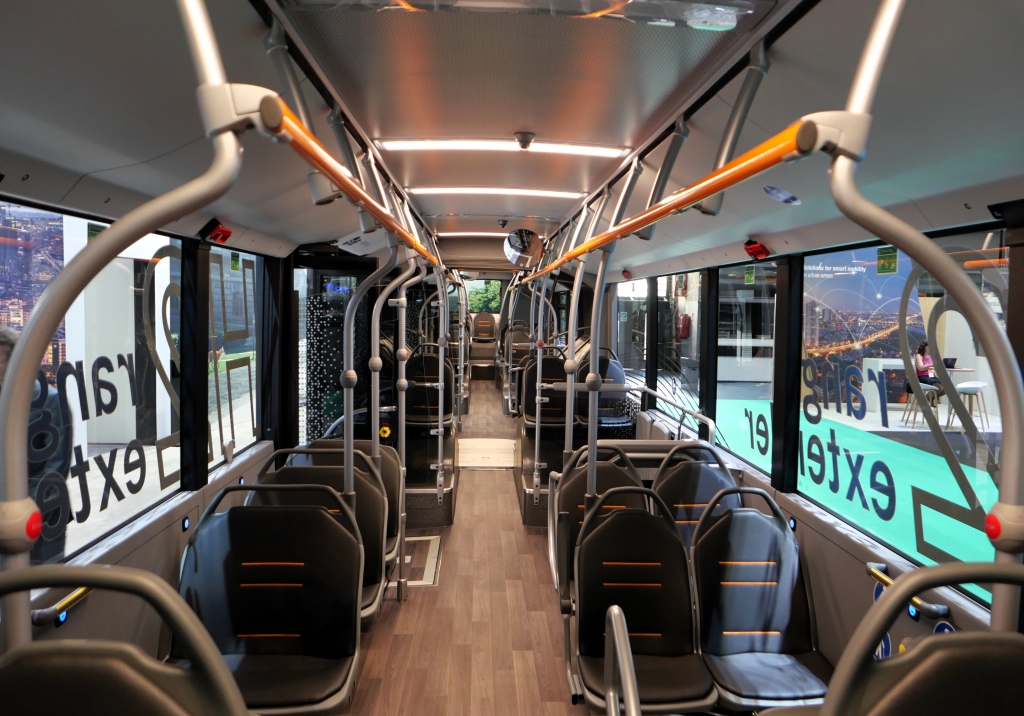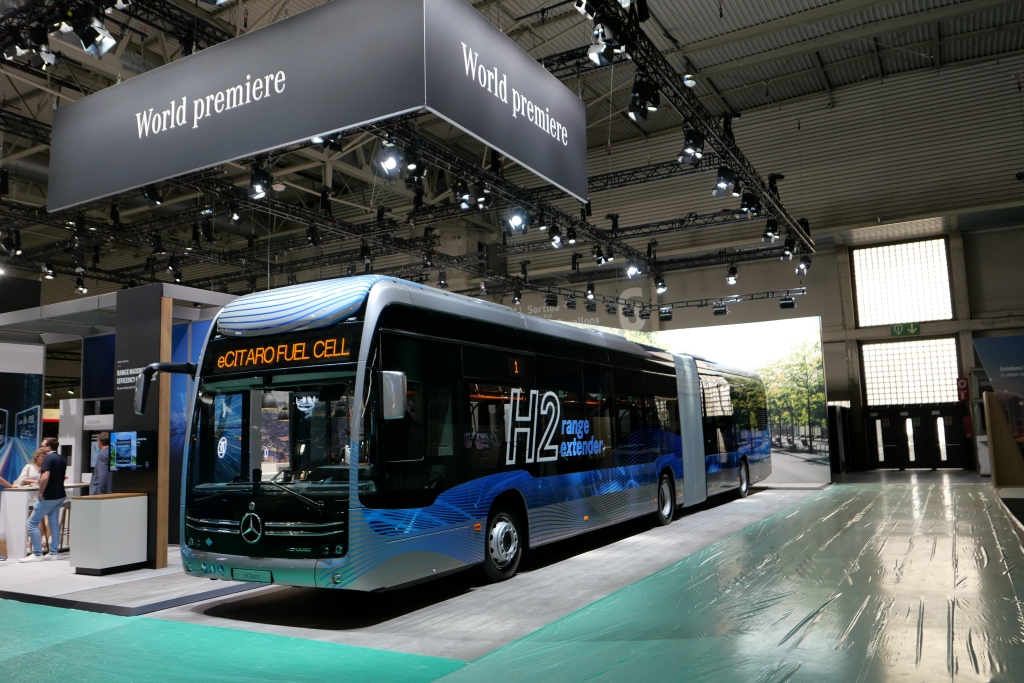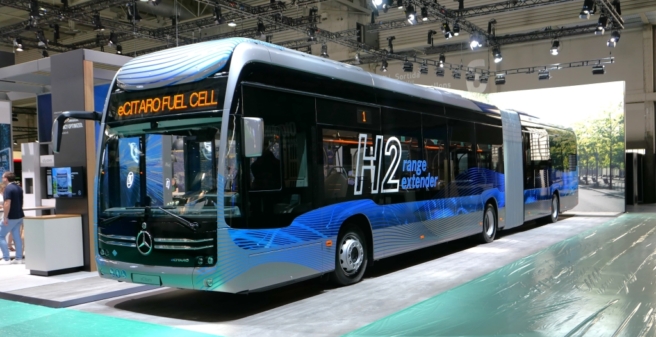
At the beginning of May last year, Daimler Truck organised the “Mercedes Buses eMobility Days” at its bus plant in Mannheim. During the presentations on site a future new model was already announced: the Mercedes eCitaro with Range Extender, i.e. a battery electric bus with a comparatively small fuel cell on board, which significantly increases the range of the bus. Recharging on the line, Mercedes already said at the appointment last year, is thus completely superfluous, recharging overnight at the depot is completely sufficient to be able to use the bus on any course of any transport company 24 hours around the clock. “With the range extender, every eCitaro can replace every diesel bus 1 : 1.”
The bus has its world premiere at the UITP Congress (Union Internationale des Transports Publics) from 4 to 7 June in Barcelona: a Mercedes eCitaro with Range Extender, i.e. the “Mercedes-Benz eCitaro Fuel Cell”.
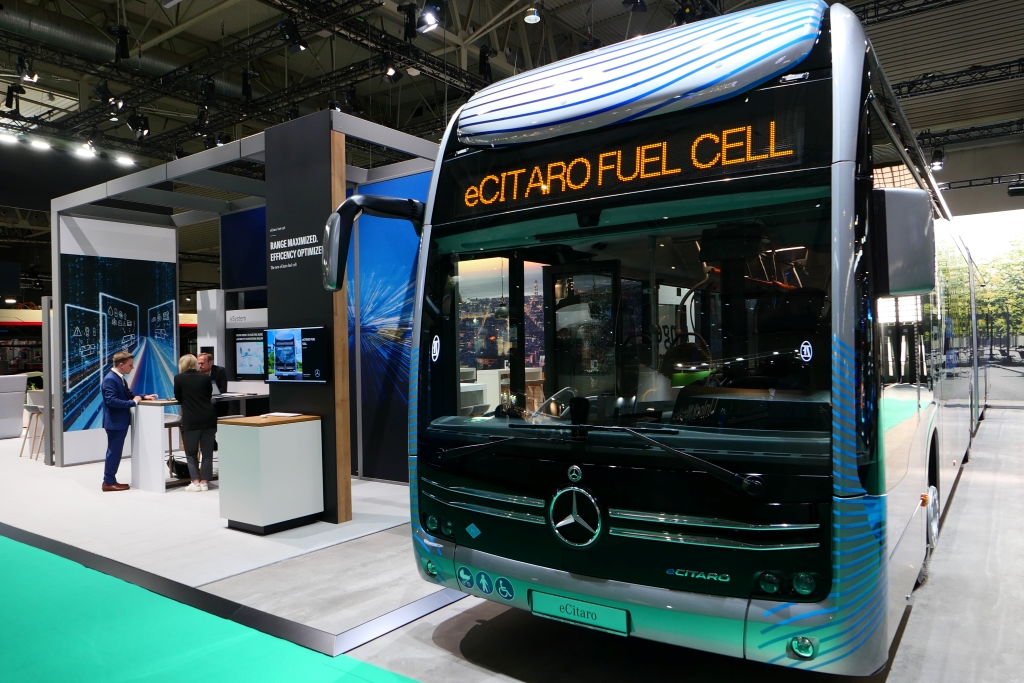
Technical concept
Mercedes first presented its Citaro city bus series as a diesel bus in 1997, and in 2018 it also came onto the market in a version as a battery electric bus (“eCitaro”). To date, the brand with the star has produced more than 60,000 vehicles in the Citaro series. Now the solo (as the “eCitaro Fuel Cell”) and articulated (as the “eCitaro G Fuel Cell”) vehicles with fuel cells as range extenders are entering the scene. Mercedes gives a range of 400 kilometres in city traffic for the solo vehicle and 350 kilometres for the articulated vehicle.
The fuel cell generates electric current by reacting hydrogen with oxygen in the air, which is stored in an “intermediate battery” and then used to drive the bus. It would be optimal if the fuel cell could work under constant conditions, but this is not possible in a city bus with its very different driving conditions. The intermediate battery must therefore be powerful enough to balance the “supply” of electricity generated by the fuel cell with the fluctuating “demand” of electricity needed for driving (acceleration, braking). According to Daimler, the problem can be solved in two ways: with a powerful fuel cell with a compact buffer battery on the one hand or with a compact fuel cell and a large buffer battery on the other.
Mercedes emphasises that it has chosen the second of these two options for good reasons. For the time being, electricity is significantly cheaper than hydrogen. That is why the fuel cell in the eCitaro does not serve as the main source of power, but only to extend the range of the bus. With the combination of large battery and compact fuel cell chosen by Mercedes, the bus is also much better able to store the electricity generated by recuperation during braking. Finally, the chosen constellation with a large battery allows higher power to be called up for longer periods in city traffic or on uphill stretches without the fuel cell having to operate in its high power range and thus uneconomically.
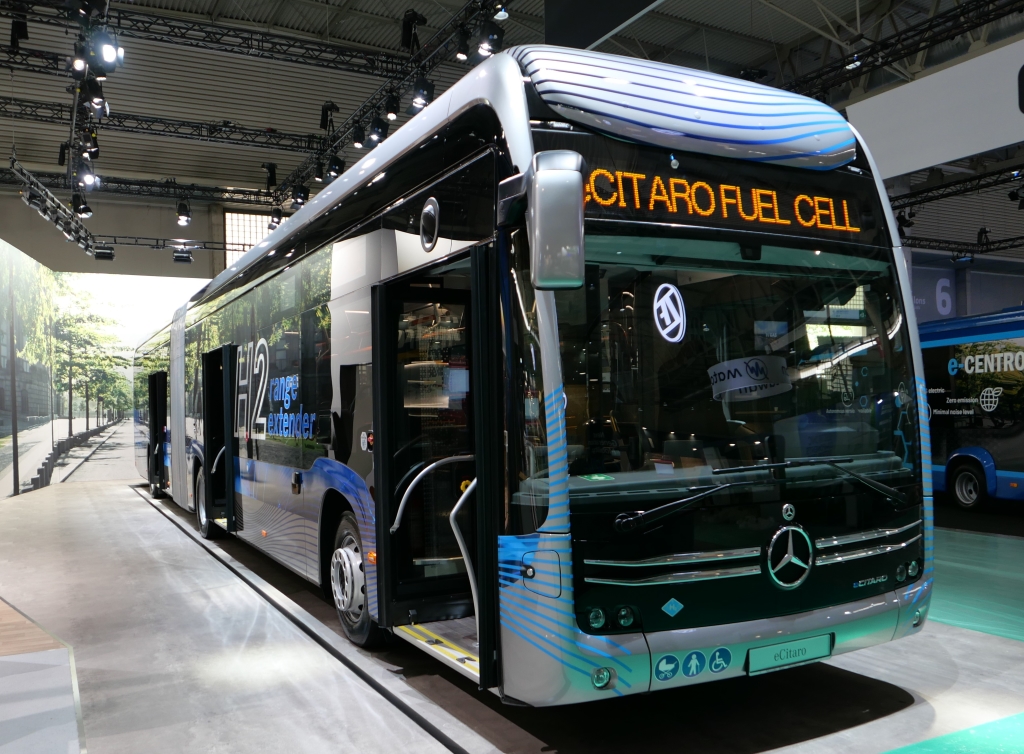
The fuel cell
The fuel cell used by Mercedes for the “eCitaro Fuel Cell” and “eCitaro G Fuel Cell” comes from the Japanese manufacturer Toyota. It has already proven itself many times over, and Mercedes is now installing the second – and thus latest – generation of the Toyota fuel cell in its buses. The module weighs about 240 kilograms; in the 12-metre-long solo bus it is located on the roof, in the articulated bus on the roof of the rear vehicle.
According to Mercedes, the fuel cell with integrated voltage converter has a high efficiency, which is why it is characterised by a low consumption of hydrogen Since it is only used as a range extender, Mercedes assumes a service life of 40,000 hours, which corresponds to a service life of 7 to 10 years, depending on the requirements of the respective application. But even after that, the fuel cell will not cease to function abruptly; rather, its performance will slowly decline and ageing processes will become apparent.
How the fuel cell works
The individual cell consists of a polymer electrolyte membrane (PEM), one negatively or positively charged electrode and two separators. The hydrogen comes via pipes from the tank on the roof to the negatively charged electrode and reacts here with the oxygen in the air. This releases electrons that travel to the positively charged electrode, generating an electric current. The hydrogen atoms become hydrogen ions, which migrate to the negatively charged electrode. As the process continues, the only “waste product” of the hydrogen drive is produced: chemically pure water (as pure as you can get from your tap at home).
Several hundred cells are needed to power an eCitaro Fuel Cell. They are combined into a fuel cell unit, the so-called “fuel cell stack”.
The hydrogen tanks
The Mercedes eCitaro Fuel Cell – both solo and articulated vehicles – use hydrogen at a pressure of 350 bar. This makes it possible to dispense with high compression and the corresponding expense at the hydrogen filling stations. This makes it possible to dispense with a high degree of compression and the corresponding expense at the hydrogen filling stations. Each of the hydrogen tanks of a bus holds five kilograms.
The hydrogen tanks consist of an inner container made of plastic and an outer casing made of carbon fibre.
The 12-metre bus has five of these hydrogen tanks with a total capacity of 25 kilograms, while the articulated coach has six or seven tanks with a capacity of 30 or 35 kilograms, depending on the customer’s wishes. The tanks are located on the roof of the bus above the front axle and front overhang, protected from dirt and sunlight at the top by cladding. The tank filler neck is located on the right side of the coach in the area of the second axle. The refuelling process takes about 10 minutes for the solo car, and (slightly) longer for the articulated car, depending on how much water it takes on board.
High-performance batteries
As with the all-electric bus eCitaro, the eCitaro Fuel Cell uses “high-performance batteries” with the latest-generation NMC 3 nickel-manganese-cobalt (NMC) cell chemistry, which, above all, have different battery cells from the previous accumulators. For while their cells resembled a pocket book in shape and size, the new cells are now cylindrical. The new cells have a capacity of 4.93 Ah and thus have about 50 % more capacity for the same weight.
Each 600 cells form a battery module, nine modules form a battery pack with 5,400 cells and a capacity of 98 kWh. The solo car has three battery packs with 294 kWh, the articulated car can have up to four packs with a capacity of 392 kWh.
Recharging takes place exclusively at the depot with a power of 150 kW. To allow the cars to be parked flexibly in their depot, Mercedes offers up to five different positions for the CCS combo sockets.
Two different operating modes are possible: one is the “maximum range” mode and the other is the “minimum hydrogen consumption” mode. In the “maximum range” mode, both the batteries and the fuel cell are used to the maximum, while in the other mode the battery takes over the main power for propulsion alone and the fuel cell only switches on when the current in the accumulator is no longer sufficient. And then it only supplies as much power as is necessary to actually achieve the preset range.
Of course, the operation of the fuel cell also produces waste heat. However, Mercedes does not simply let it escape into the environment, but uses it to heat the bus and the batteries. The driver’s seat and the passenger compartment are heated independently of each other, so the driver can adjust the temperature at his workplace to his individual comfort.
The drive axle
Mercedes also uses the AVE 130 from ZF with motors close to the wheel hub as the drive axle in the “eCitaro Fuel Cell” – which also does its job in the eCitaro. But this is not surprising, as the drive in the eCitaro Fuel Cell is purely electric, just like in the eCitaro. The electric motors produce 125 kW per wheel, so the bus has a total of 250 kW.
